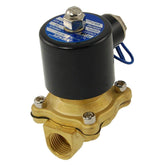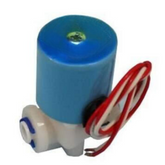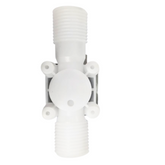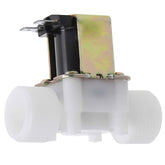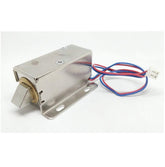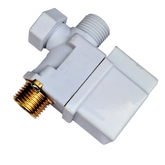Solenoid Valve - How They Work
Summary
Do you want to know the entire functioning of the Solenoid valve? If Yes, then this blog post is for you! this post covers all the essential information about Solenoid valves like How does a solenoid valve work? circuit functions, types, working principle and features, Ready to be amazed by knowing how this amazing prodct works
Introduction
A solenoid valve is a device used to control the flow of liquid or gas. It works by relying on an electromagnetic coil winding and two ports for fluid, usually from a pressurized source.
When it's energized, this action will cause the plunger in the middle to move which opens up one port and closes off another allowing fluids to flow freely through only that specific path determined by its design inputs.
This can be used for controlling liquids like oil, water or fuel as well as gases such as air and natural gas safely with precision accuracy thanks to automation technology behind it--essential in today's modern world operations where quick response times are required effectively.
The higher voltage applied across its coils increases force output exponentially resulting in quicker responses when faced with even larger volumes of pressure thus making them suitable solutions when reliability matters most.
How does a solenoid valve work?
A solenoid is a device that generates an electromagnet when current is fed through it and is made of an electric coil wrapped around a ferromagnetic material, such as iron.
Different solenoid valves have other electric current properties, magnetic field strengths, and fluid regulation mechanisms. The mechanism ranges from linear action and plunger-type actuators to pivoted-armature actuators and rocker actuators.
The valve may have a two-port configuration to control a flow or a three-port configuration or more to switch flows between ports. A manifold can accommodate a grouping of solenoid valves.
The most often utilized control components in fluidics are solenoid valves. Their duties include turning off, releasing, dosing, distributing, and mixing fluids. They are utilized in numerous fields.
Fast and secure switching, long service life, high reliability, good medium compatibility of the materials employed, low control power, and compact design are all advantages of solenoids.
Solenoid valves are electrically operated valves. In a valve, a solenoid is an electric coil with a ferromagnetic core (plunger) in the middle.
In the rest position, the plunger closes off a small aperture, which is the fundamental principle behind solenoid valves.
A magnetic field is produced by an electric current flowing through the coil. The plunger is forced upward by the magnetic field, opening the hole.

Fig.1. Typical solenoid valve
It contains two main components, which are the solenoid and valve body, iron core known as the plunger is encircled by an electromagnetic inductive coil (A) at the Centre of a solenoid (E).
It might be typically open (NO) or normally closed when at rest (NC). A usually closed valve is closed and a normally open valve is open in the de-energized state.
The solenoid's coil is energized and produces a magnetic field when current runs through it. This moves the plunger and displaces the spring (D) force by creating a magnetic attraction between them. When the plunger is raised, the seal (F), ordinarily closes the orifice and prevents media flow.
If The plunger lowers, causing the seal (F) plugs the orifice and halts media flow through the valve. The shade ring (C) stops the AC coils from vibrating and buzzing.
With high or low pressures and small or large flow rates, solenoid valves are employed in a variety of applications. These solenoid valves operate according to various principles, depending on what is best for the purpose.

Fig.2. Components of a solenoid valve
In other words, A voltage is delivered to the winding of a solenoid to generate a magnetic field. The enormous inductance of the winding causes the current to develop gradually.
According to the current, there is a corresponding force on the solenoid's core. A high voltage must be given to the winding to quickly create the current to move the core with the greatest amount of force possible.
Once the motion is finished, the core can typically be held in place with a considerably smaller current. If the current isn't decreased, a significant quantity of power is lost in the winding and the solenoid produces a large amount of heat.
A constant-current driver that drives the solenoid can be employed to address these issues. To give the best actuation and reduce the amount of energy used to hold the solenoid in position, the current can be gradually regulated.
The way solenoid valves function is another way to identify them. A tiny solenoid can only provide a modest amount of force. For a direct-acting solenoid valve, the needed solenoid force Fs, the fluid pressure P, and the orifice area A roughly relate to the following 
The solenoid can directly actuate the main valve if the required force is minimal enough. Direct-Acting solenoid valves are the generic name for them.
Electrical energy is transformed into mechanical energy when electricity is delivered, physically moving a barrier to either allow flow or block flow. Once the power is turned off, the spring is frequently utilized to bring the valve back to its resting position.
Direct-acting valves are practical due to their simplicity, although they are more power-hungry than other kinds of solenoid valves.
Circuit functions of solenoid valve
To stop, start, dose, distribute, or mix the flow of gas or liquid in a pipe, solenoid valves are utilized. A solenoid valve's circuit function reveals its precise function. Below is a description of 2-way and 3-way solenoid valves. For a thorough comprehension of symbols and a comprehension of circuit function diagrams,
Two Way solenoid valve:
An inlet and an exit are the two ports on a two-way solenoid valve. The flow direction is usually indicated by an arrow because it is essential for optimal operation. The orifice can be opened or closed using a 2-way valve. An illustration of a 2-way solenoid valve is shown in Figure 3.

Fig.3. Two-way solenoid valve
Three Way solenoid valve:
There are three connecting ports on a 3-way valve. There are typically 2 states (positions) that it can be in. As a result, it alternates between two circuits. Media can be opened, closed, distributed, or mixed with a 3-way valve. An illustration of a 3-way solenoid valve is shown in Figure 4.

Fig.4. Three-way solenoid valve
Four Way solenoid valve:
In a 4-way valve, all ports are by default turned off. They have two exhaust ports and produce two states or actions. By connecting a flow control valve to each exhaust port, you may regulate the rate of each activity. An illustration of a 4-way solenoid valve is shown in Figure 5.

Fig.5. Four-way solenoid valve
Solenoid valve types
There are three types of solenoid valves- Normally closed solenoid valve
- Normally open solenoid valve
- Bi-stable solenoid valve
1) Normally closed solenoid valve:
When a usually closed solenoid valve is de-energized, the valve closes and prevents media flow.
When electricity is applied to the coil, an electromagnetic field is produced that pushes the plunger higher against the spring force. With the seal broken, the orifice is now free to allow media to pass through the valve.
Figure 5 depicts the functionality of a typical closed solenoid valve in both its deactivated and activated states.
2) Normally open solenoid valve:
A typically open solenoid valve allows media to flow through it even when it is de-energized. When current is applied to the coil, an electromagnetic field is produced that pushes the plunger down against the force of the spring.
Media cannot flow through the valve as a result of the seal closing and seating in the orifice. A typically open solenoid valve's operation is depicted in Figure 6 in both its energized and de-energized phases.
For applications where the valve must be left open for extended periods, a normally open solenoid valve is the best option because it uses less energy.
3) Bi-stable solenoid valve:
A temporary power source can flip a bi-stable or latching solenoid valve. It will then remain powerless in that condition.
As a result, it is neither normally open nor normally closed because it maintains its current state in the absence of power. Instead of a spring, they use permanent magnets to achieve this.
Working principle of solenoid valve:
Direct action:
Figure 2 shows the components and operating concept of direct acting (direct operated) solenoid valves. When a usually closed valve is not powered, the valve seal and plunger (E) obstruct the orifice (F). This closure is forced by a spring (D).
Powering the coil (A) produces an electromagnetic field that attracts the plunger upward and displaces the spring force.
As a result, the orifice is opened, and the media can now pass through. The identical parts make up a typically open valve, which operates oppositely.
The orifice diameter and magnetic force of the solenoid valve are closely correlated with the maximum operating pressure and flow rate. Solenoid valves with direct acting are often utilized for relatively low flow rates.
Direct-driven solenoid valves can be utilized from 0 bar to the maximum permitted pressure because they don't need a minimum operating pressure or pressure differential.
Indirect action:

Fig.6. Principle of the indirect action
Indirect-acting solenoid valves also known as servo-operated or pilot-operated valves, open and close the valve by utilizing the pressure difference between the medium at the valve's inlet and output ports.
They normally need a minimum pressure differential of about 0.5 bar as a result. Figure 6 illustrates the indirect-acting solenoid valve. A diaphragm, or rubber membrane, separates the inlet and output ports.
A tiny hole in the membrane allows the medium to pass from the entrance to the top compartment. A typically closed indirect-acting solenoid valve will stay closed as long as the inlet pressure (above the membrane) and supporting spring are present.
A narrow passage links the low-pressure port to the chamber above the membrane. The plunger and valve seal restrict this connection when the valve is closed.
This "pilot" orifice has a diameter that is greater than the membrane hole's diameter. The pilot orifice opens when the solenoid is activated, which lowers the pressure above the membrane.
The membrane will be elevated as a result of the pressure difference on each side of the membrane, allowing the medium to flow from the inlet port to the outlet port. The identical parts make up a typically open valve, which operates oppositely.
A small solenoid can nonetheless control a high flow rate because of the amplifier-like effects of the additional pressure chamber above the membrane.
Media flow in one direction is the sole application for indirect solenoid valves. Applications requiring a large, desired flow rate and a suitable pressure differential use indirect-driven solenoid valves.
Semi-direct action:

Fig.7. Principle of the semi-direct action
The characteristics of direct and indirect valves are combined in semi-direct acting solenoid valves. Because of this, they can operate at zero bar while still having a high flow rate.
They have a moveable membrane with tiny openings and pressure chambers on both sides, and they resemble indirect valves in appearance.
The solenoid plunger's direct connection to the membrane marks a distinction. Figure 7 illustrates the semi-direct acting solenoid valve. The membrane is directly lifted when the plunger is raised, opening the valve.
The plunger simultaneously causes a second hole in the membrane, which has a slightly bigger diameter than the first orifice, to open.
As a result, there is a decrease in pressure in the chamber above the membrane. As a result, the membrane is raised by both the pressure difference and the plunger.
3-way direct acting:
The operation of a 3-way solenoid valve depends on whether you want a mixing (two inlets and one outlet) or a diverting (one inlet and two exits).
A valve's ability to operate in both directions is known as a universal circuit function. Each state only has two ports linked, though. A three-way direct-acting solenoid valve is illustrated in Figure 8 as an example.

Fig.8. Principle of the 3-way direct action
There are only two ports connected at once. In Figure 8, the plunger has two valve seats and orifices on the top and bottom of it. To route the media in the proper flow direction, one is open, and one is closed at any given time.
Special solenoid valve features
- Electricity is lowered by a sufficient amount to maintain the valve in place when a brief current pulse is used to open or close it. This promotes energy conservation.
- Latching: For applications requiring low-frequency switching, latching or a pulse coil variant is an option. A brief electric pulse is used to activate the valve and move the plunger. The plunger is then held in that place without the assistance of a further spring or magnetic field by a permanent magnet. As a result, the valve's heat generation and power consumption are reduced.
- High Pressure: Versions for high pressure are made to withstand pressures of up to 250 bar.
- Better safety and convenience are provided by the optional manual override feature during commissioning, testing, maintenance, and in the event of a power outage. In some variations, when the manual control is locked, the valve cannot be electrically actuated.
- Separation of the media from the functioning portions of the valve is made possible by the media separation design, which makes it an excellent option for abrasive or mildly polluted media.
- Vacuum: For rough vacuums, valves that don't need a minimum pressure differential are appropriate. For these applications, universal direct-acting or semi-direct acting solenoid valves work effectively. There are specific vacuum versions available for requirements with a stricter leakage rate.
Conclusion:
In this blog post, we have learnt that Solenoid valves are paramount elements in fluid control systems, leveraging electromagnetic energy to govern the progression of liquids or gases.
Grasping the functioning of a solenoid valve is crucial for selecting the apt type for your precise application, guaranteeing proficiency and dependability in operation.
These valves are pivotal in preserving fluid flow, hence investing in premium quality solenoid valves ensures optimal performance and durability in your system.
If you appreciate our work don't forget to share this post and leave your opinion in the comment box.
Please do check out other blog posts about Popular electronics
Make sure you check out our wide range of products and collections (we offer some exciting deals!)



